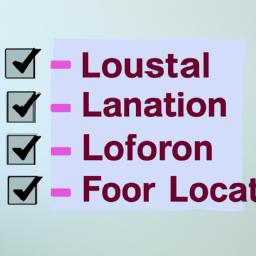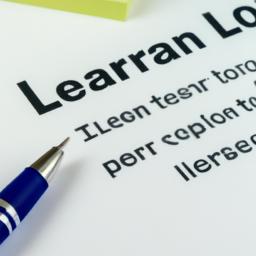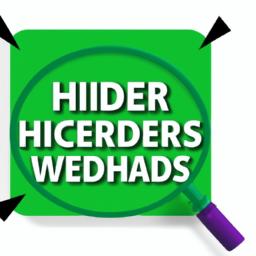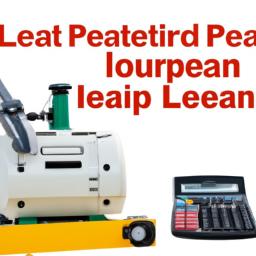In the intricate dance of business operations, the rhythm is often set by the tools at our disposal. From construction behemoths to sleek office technology, equipment can make or break the tempo of productivity. Yet, behind the shine of new machinery and the allure of cutting-edge gadgets lies an unavoidable question: “How much will an equipment loan cost?” For those venturing into this financial territory, understanding the true expense is paramount. This article delves into the layers of decision-making, financial forecasting, and strategic planning essential in deciphering the real cost of an equipment loan. Whether you’re a seasoned entrepreneur or a budding startup visionary, join us as we unpack the elements that determine what you’ll ultimately pay to bring your business’s essential equipment to life.
Factors Influencing Equipment Loan Costs
When seeking an equipment loan, several factors come into play that can influence the overall cost. One of the most significant aspects is the interest rate. Lenders offer varying interest rates based on market conditions, the borrower’s credit score, and other risk factors. A higher interest rate can significantly increase the total repayment amount, making it essential to shop around for the best possible rate.
Another critical factor affecting loan costs is the loan term. While a longer loan term may result in lower monthly payments, it can also mean paying more in interest over the life of the loan. Conversely, a shorter loan term might have higher monthly payments but could save money in the long run by reducing the amount of interest paid.
The type of equipment being purchased can also impact loan costs. More expensive or specialized equipment may come with higher price tags, leading to larger loan amounts and, consequently, more interest accrued over time. Additionally, the depreciation rate of the equipment can influence a lender’s willingness to offer favorable terms.
One should also consider the down payment requirement. A larger down payment reduces the principal amount that needs to be financed, potentially lowering both the interest rate and the monthly payments. Some lenders might offer better terms if the borrower can put down a substantial initial amount.
The borrower’s credit history and business financials play a crucial role as well. Strong credit scores and healthy financial statements can lead to more favorable loan terms, including lower interest rates and better loan conditions. Lenders often assess the risk based on these factors, so maintaining good credit and transparent financial records is beneficial.
There are also various fees and charges associated with equipment loans that can affect the overall cost. These may include origination fees, application fees, and prepayment penalties. It’s essential to read the fine print and consider these additional costs when calculating the total expense of the loan.
To illustrate the potential impact of these factors, here’s a typical breakdown of costs for different scenarios:
| Scenario | Total Loan Amount | Interest Rate | Monthly Payment | Loan Term |
|---|---|---|---|---|
| High Credit Score, 20% Down Payment | $50,000 | 5% | $943 | 60 months |
| Low Credit Score, 10% Down Payment | $50,000 | 10% | $1,065 | 60 months |
| High Credit Score, 0% Down Payment | $50,000 | 7% | $990 | 60 months |
Beyond these factors, many lenders offer promotional deals or seasonal discounts which can temporarily reduce costs. Keeping an eye out for these special offers can be a great way to secure a more economical loan. Moreover, negotiating with lenders by showcasing business stability and growth prospects can sometimes yield better terms.
the cost of an equipment loan hinges on multiple dynamic factors ranging from interest rates and loan terms to credit scores and down payments. Thoroughly understanding and optimizing these variables can lead to significant savings and make the loan more affordable in the long run.

Understanding Interest Rates and Loan Terms
When evaluating how much an equipment loan will cost, it’s important to start by understanding the interest rates and loan terms that apply. Interest rates can be influenced by a variety of factors, including your credit score, the state of the economy, and the length of the loan term. Different lenders will offer different rates, so it’s crucial to shop around and compare offers.
Interest rates are typically expressed as an Annual Percentage Rate (APR). This percentage indicates the yearly cost of the loan, making it easier to compare different loan offers. Lower interest rates will decrease the total cost of the loan, while higher rates will increase it. Here are some factors that can influence your rate:
- Credit Score
- Loan Amount
- Loan Term
- Current Economic Conditions
The loan term is the length of time you have to repay the loan. Loan terms for equipment financing usually range from 1 to 7 years. Shorter loan terms typically result in higher monthly payments but lower total interest costs. Conversely, longer terms mean lower monthly payments but higher accumulated interest.
Understanding how interest rates and loan terms affect your monthly and overall payments can help you make an informed decision. Let’s break down an example:
| Loan Amount | Interest Rate | Term (Years) | Monthly Payment | Total Interest Paid |
|---|---|---|---|---|
| $50,000 | 5% | 3 | $1,498.88 | $4,960 |
| $50,000 | 5% | 5 | $943.56 | $6,613 |
| $50,000 | 5% | 7 | $707.10 | $9,548 |
As the table illustrates, a shorter loan term results in higher monthly payments but less total interest paid. On the other hand, a longer term reduces your monthly burden but increases the overall cost of the loan due to accruing interest.
Some lenders might offer fixed interest rates, while others may offer variable rates. Fixed rates remain the same throughout the life of the loan, providing predictability in your payments. Variable rates, however, may change over time, potentially lowering or increasing your monthly costs. It’s worthwhile to understand the risks and benefits associated with each type.
Additionally, be aware of any associated fees and charges. Loan origination fees, late payment penalties, and early repayment charges can add to the cost. Make sure you read the fine print of any loan contract to understand all the costs involved.
Ultimately, the best equipment loan for your business will depend on your specific financial situation, your future revenue projections, and how quickly you plan to pay off the loan. By carefully considering the interest rates and loan terms, you can ensure that you’re making the best financial decision for your company’s growth and sustainability.
To get started, use online calculators that can help you estimate your monthly payments and the total loan cost based on different scenarios. Armed with this knowledge, you’ll be better positioned to negotiate with lenders and secure the best deal possible.

Hidden Fees and Additional Charges to Watch Out For
When securing an equipment loan, it’s essential to scrutinize the details to avoid surprises when it comes to extra costs. Among the obvious interest rates, the subtler hidden fees and surcharges can significantly impact your overall expenditure. Here are some you should be vigilant about:
- Origination Fees: This is a one-time fee that lenders charge for processing your application. It’s typically a percentage of the loan amount and can add up quickly.
- Documentation Fees: Administrative costs for preparing and filing necessary documentation might seem nominal at first but can accumulate.
- Late Payment Fees: Paying late can result in hefty fines, often way out of proportion to the actual delay.
Beyond these, many agreements include maintenance or servicing fees. Lenders sometimes charge a monthly fee for maintaining the loan, which can catch borrowers off guard.
Common Fees Breakdown
| Fee Type | Description | Typical Amount |
|---|---|---|
| Origination | Processing your loan | 1-5% of loan amount |
| Documentation | Preparation of paperwork | $100-$300 |
| Late Payment | Penalty for late payment | $25-$50 |
Another common hidden cost is the prepayment penalty. While paying off your loan early might seem financially prudent, some lenders impose penalties for this, which can negate the benefits of early repayment.
- Insurance Costs: Borrowers might be required to insure the equipment, adding ongoing costs that need to be factored into the total expense.
- Transaction Fees: If your loan involves transfers or multiple financial transactions, watch for smaller fees that accumulate unnoticed.
- Balloon Payments: Some loans have lower monthly payments but require a large sum at the end of the term, which could be a financial shock.
Maintenance costs are not always highlighted in loan agreements. If the equipment needs regular upkeep, it’s wise to clarify whether such costs are covered or if they will be an out-of-pocket expense.
Additionally, watch out for state taxes and levies that may not be included in the quoted loan amount but are payable as part of the equipment usage. These can vary widely depending on your location and the type of equipment.

Tips for Getting the Best Deal on Your Equipment Loan
Securing an equipment loan can be a significant investment, whether you’re a small business owner or an individual looking to finance new machinery. Here are some savvy tips to make sure you’re getting the best deal possible.
Shop Around for Lenders
Just as with any other substantial purchase, it pays to compare multiple options. Different lenders will offer varied interest rates, terms, and conditions. Consider both traditional banks and alternative lending institutions. It’s worth taking the extra time to gather quotes and negotiate terms to ensure you are securing the best possible deal.
Understand Your Credit Score
Your credit score plays a pivotal role in determining the interest rate and loan terms you’ll be offered. Before applying for a loan, check your credit report and scores to ensure everything is accurate. Improving your credit score can lead to better offers and save you money over the life of the loan.
Evaluate the Total Cost
It’s crucial to consider the total cost of the loan, not just the monthly payments. Look at the Annual Percentage Rate (APR), which includes interest as well as other fees. This will give you a clearer picture of what the loan will truly cost you over its term. Don’t be swayed by seemingly low monthly payments if it means you’re paying more in interest over time.
Consider Loan Term Length
While longer loan terms can reduce your monthly payments, they can also result in paying more in interest over the life of the loan. Balance your need for manageable monthly payments with the overall cost to find the optimal loan term length.
Factor in Prepayment Penalties
Some lenders charge a fee if you decide to pay off your loan early. This prepayment penalty can add significant costs if you plan to pay off your loan ahead of schedule. Always read the fine print and ask the lender about any penalties for early repayment before committing.
Review Hidden Fees
Lenders may charge various fees, including application fees, processing fees, and late payment penalties. These can add up quickly and increase the overall cost of your loan. Ensure you understand all potential fees and factor them into your decision-making process.
| Lender | Interest Rate | Loan Term | Special Fees |
|---|---|---|---|
| Bank A | 5% | 5 years | No prepayment penalty |
| Lender B | 4.8% | 3 years | Processing fee: $150 |
| Institution C | 6% | 7 years | Early repayment fee: 1% |
Seek Professional Advice
Consulting with a financial advisor or loan expert can provide valuable insights into which loan options are best suited for your specific needs. They can help you navigate the complexities of loan agreements and ensure you understand the financial implications of your decision.
By carefully considering these factors, you can make an informed decision and secure the best possible equipment loan for your needs.
The Way Forward
As you venture down the path of securing an equipment loan, remember that knowledge is your steadfast companion. By understanding the components of loan costs—interest rates, terms, fees, and collateral—you empower yourself to make decisions that resonate with your financial harmony. The journey may seem intricate, but meticulous planning and informed choices will sculpt a future where your business not only thrives, but flourishes. Keep your eyes on the horizon, and let the numbers guide you to prosperity.
